Specimen Collection & Transport
Blood Collection Tubes
Blood collection tubes are part of the Evacuated Tube System (ETS) for collecting blood specimens.
All tubes contain a premeasured amount of vacuum. When the multiple sample needle system is used, blood is pulled directly from the patient’s vein into the tube. When the vacuum has been expended, the blood will stop flowing.
If multiple tubes are being drawn on a patient, after the first tube is withdrawn from the holder, the rubber sheath slides over the end of the needle. This prohibits the blood from flowing until the second tube is engaged in the holder, pushing the rubber sheath back and allowing the blood flow to continue.
Specimen Collection & Transport
Types of Tubes
Collection tubes are color-coded according to the tube’s additive.
The following is a list of tubes, additives present, and the state of those additives.
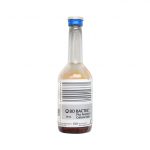
Blood Culture: Aerobic Medium (Grey/Blue)
Aerobic medium is an all-purpose, enriched soybean-casein digest broth medium capable of supporting the growth of aerobic organisms.
This medium contains resins for antibiotic neutralization.
Mix by inverting 8 to 10 times.
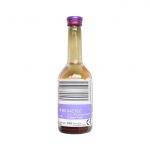
Blood Culture: Anaerobic Medium (Purple)
Anaerobic medium is designed to increase the detection and recovery of anaerobes.
It contains a detergent to lyse both red and white blood cells present in the sample, releasing any intracellular organisms.
Mix by inverting 8 to 10 times.
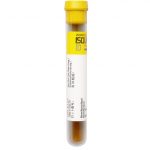
Fungal: ISOLATOR™ Tubes
Contains lysing and anticoagulating agents, which are specifically designed for the collection and isolation of microorganisms from blood.
Mix by inverting 3 to 4 times.
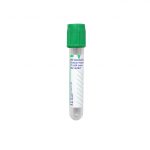
Green Sodium Heparin
Contains sodium heparin, vapor-coated or solid disc.
Prevents clotting by inactivating thrombin and thromboplastin.
Used for chromosome and tissue typing studies.
Mix by inverting 8 to 10 times.

Green Lithium Heparin
Contains lithium heparin, disc.
Inactivates thrombin and thromboplastin.
Used in testing certain drug levels.
Mix by inverting 8 to 10 times.
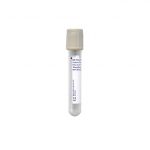
Grey Sodium Fluoride & Potassium Oxalate
Contains potassium oxalate and sodium fluoride, powder.
Potassium oxalate binds with calcium to inhibit clotting. Sodium fluoride inhibits glycolysis.
Used for glucose levels in GTT’s, pyruvate, and lactic acid.
Mix by inverting 8 to 10 times.

Gold Serum Separation (SST)
Contains no anticoagulant.
Plastic tube contains micronized silica particles as a clot activator and a polymer gel that forms a barrier between the serum and red blood cells.
Mix by inverting 5 times.

Lavender K2EDTA
Contains K2EDTA, liquid.
Inhibits clotting by binding with calcium.
Ideal for Complete Blood Count (CBC) testing because it does not change cell morphology.
Mix by inverting 8 to 10 times.
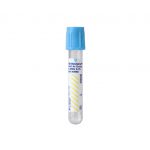
Light Blue Sodium Citrate Coagulation
Contains buffered 3.2% sodium citrate, liquid.
Sodium citrate binds with calcium, thereby keeping the blood in a liquid state.
Used for anticoagulation testing.
Mix by inverting 3 to 4 times.
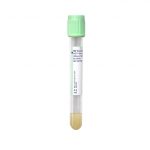
Light Green Lithium Heparin Plasma Separator (PST)
Contains lithium heparin.
Lithium heparin inactivates thrombin and thromboplastins. A polymer gel forms a barrier between the plasma and red blood cells, white blood cells, and platelets after centrifugation.
Inhibits remixing during transport.
Mix by inverting 8 to 10 times.

Royal Blue (Purple Stripe) with K2EDTA
Contains spray-dried K2EDTA; vapor coated and acid-washed to remove metal contaminants. Trace metal-free.
Inactivates thrombin and thromboplastin.
Used in some trace-metal testing and nortryptyline levels.
Mix by inverting 8 to 10 times.
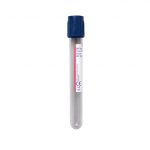
Royal Blue (Red Stripe), Plain
Used for aluminum level testing. Trace metal-free.
This tube has a clot activator sprayed inside.
Mix by inverting 5 times.
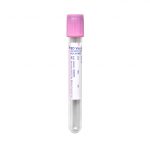
Pink K2EDTA Whole Blood
Contains K2EDTA.
Standard use for blood bank tests.
Mix by inverting 8 to 10 times.

Red Serum (No Additive)
Contains no anticoagulant.
The plastic tube contains micronized silica particles as a clot activator.
Used most commonly for cryoglobulin testing.
Mix by inverting 5 times.
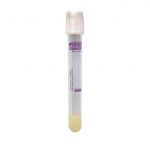
White K2EDTA Plasma Preparation (PPT)
Contains a spray-dried EDTA and separator gel.
Used in HIV RNA by PCR testing.
Mix by inverting 8 to 10 times.
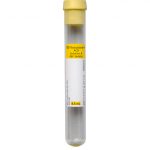
Yellow (Glass) Whole Blood ACD – Solution A
Glass tube contains 1.5 mL Acid Citrate Dextrose (ACD) Solution A liquid: trisodium citrate (22.0g/L), citric acid (8.0g/L), and dextrose (24.5g/L).
Used for blood banking studies, HLA phenotyping, DNA testing, and paternity testing.
Mix by inverting 8 to 10 times.
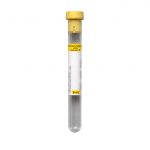
Yellow (Glass) Whole Blood ACD – Solution B
Glass tube contains 1 mL Acid Citrate Dextrose (ACD) Solution B liquid: trisodium citrate (13.2g/L), citric acid (4.8g/L), and dextrose (14.7g/L).
Used for blood banking studies, HLA phenotyping, DNA testing, and paternity testing.
Mix by inverting 8 to 10 times.
Recommended Order of Draw
The following draw order is recommended when drawing multiple specimens for clinical laboratory testing during a single venipuncture.
Color
Tube Type
Additives & Mode of Action
Blood Culture:
Aerobic (Grey/Blue) or Anaerobic (Purple)
Aerobic / Anaerobic Culture Media
Mix by inverting 8 to 10 times
Light Green
Lithium Heparin Plasma Separator
Lithium Heparin with Gel Separator
Mix by inverting 8 to 10 times
Royal Blue
with K2EDTA (Purple Stripe)
Ethylenediaminetetraacetic Acid (EDTA)
Mix by inverting 8 to 10 times
Spray-dried Ethylenediaminetetraacetic Acid (EDTA)
Mix by inverting 8 to 10 times
Sodium Fluoride / Potassium Oxalate
Mix by inverting 8 to 10 times
Tube Storage & Inspection
Storage
Store all collection tubes according to the manufacturer’s recommendations.
In addition, all storage locations should be monitored for appropriate temperature conditions.
Inspection
Employ a method for maintaining appropriate inventory to prevent unnecessary excess supply.
Review existing inventory for expired tubes at a defined schedule. If expired tubes are found, remove them from inventory immediately.
All tubes should be inspected just before use.
Proper Filling of Tubes
The vacuum in each tube draws in a pre-measured amount of blood.
If the tubes are not completely filled to the optimal level, they may still contain enough blood to perform the test.
Review the Test Directory or contact Client Services to confirm the required amount of blood before redrawing the patient’s blood.
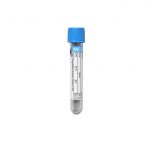


Collecting Proper Volumes of Blood for Test Requirements
It is important to remember that all blood tests require a minimum amount of blood. Review specimen volume requirements in the Test Directory.
When tubes are referred to by color only, determine how much blood is required, then use the proper amount of tubes to collect the specimen.
Whole Blood
When tests require whole blood, drawing the amount of blood required is sufficient to perform the test.
Example: If a test requires 5 mL of EDTA whole blood, then a 2.5 mL purple tube cannot be used to procure the specimen.
Plasma / Serum
When tests require plasma and serum, remember that they are only portions of the total amount of blood drawn.
Example: If 5 mL of serum is required for a test, drawing 5 mL of blood would yield an insufficient amount of serum.
Proper Mixing of Tubes
- Light blue sodium citrate tubes should be inverted 3-4 times.
- Serum analysis tubes should be inverted 5-6 times.
- All other tubes should be inverted 8-10 times.
Avoiding Hemolysis
Violent shaking of tubes with or without an anticoagulant present will cause the red blood cells to break and release their components into the plasma or serum. This results in a hemolyzed specimen.
Hemolysis renders a blood sample useless for most laboratory procedures, causing abnormal test results.
References
Garza, D., McBride, K.B.: Phlebotomy Handbook, Ninth Edition. Boston, Pearson Education, 2017
B. Keichle, F. “So You’re Going to Collect a Blood Specimen”: An Introduction to Phlebotomy, Fifteenth Edition, College of American Pathologists. Danville: 2017
C. McCall, R., Tankersley, C., Phlebotomy Essentials, Sixth Edition. Philadelphia, Wolters Kluwer, 2016
